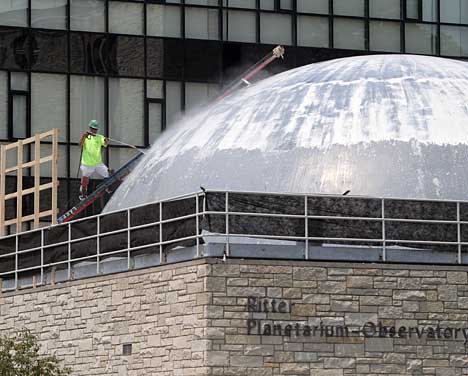
A worker from Lakeside Interior Contractors Inc., Perrysburg, power-washed the paint off Ritter Planetarium’s dome earlier this month. The structure has been repainted as part of the renovation.
Ritter Planetarium will be the first planetarium in the world to house a new SciDome XD projector system, which will use two ultra-bright digital projectors that will transmit more than six million pixels onto the building’s 40-foot dome.
The three-dimensional computerized space simulator is one of a number of upgrades under way at Ritter Planetarium, which has been the center for astronomical education in Toledo since it opened in 1967.
The planetarium renovation also will include a 5.1 surround-sound system and new seating and carpeting to be installed this summer.
“The planetarium is a great opportunity for UT to put its best foot forward,” said Alex Mak, associate director of Ritter Planetarium. “Between 15,000 and 20,000 students visit us each year, so it’s a way to give students, teachers and principals a good impression of the University.”
The SciDome XD system, designed by Spitz Inc., is based on the SciDome system first introduced in 2002. It will replace the original Spitz A3P projector that Professor Emerita Helen Brooks and her husband, Elgin Brooks, designed the Ritter Planetarium around, as well as its current slide projectors, special effects projectors and sound system. Helen served as associate director of the planetarium from 1969 to 1972.
When it opened in 1967, Ritter Planetarium was the state-of-the-art facility where UT students learned astronomy. When McMaster Hall was built next door 20 years later, the astronomy classes moved there; this opened the planetarium during the day and allowed Ritter’s K-12 programs to grow, nearly doubling the attendance.
Today, the planetarium hosts between 200 and 300 programs each year and attracts visitors from a three-state area. It is not uncommon for school groups to visit from 50 or 60 miles away, Mak said.
“Astronomy is a big part of the Ohio science standards,” Mak said. “The new technology will help us work with and prepare students and teachers to meet these standards.”
The renovation also will enable new multidisciplinary opportunities that will expand the use of the planetarium beyond astronomy to many other types of programs.
From school groups to the general public, the planetarium serves 20,000 to 25,000 patrons on average each year, according to Mak.
The planetarium also is extensively used by University students; during the Astronomy 1010 course, which is taken by almost 2,000 students per year, each spends about two hours in Ritter.
Mak said it’s important the planetarium maintains the “unbelievable customer service” that makes Ritter a very personal, interactive facility and blend that service with updated technology.
The project is estimated to be completed in early October, but a firm date has not been set for Ritter Planetarium’s grand re-opening, which will include several UT and community events, including a series for teachers and principals in area K-12 schools and a weekend-long event for the public.
For renovation updates, go to www.utoledo.edu/as/rpbo/spitz_upgrade.html.